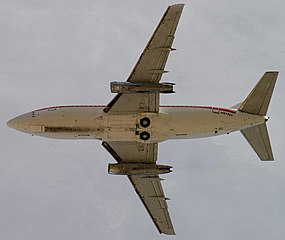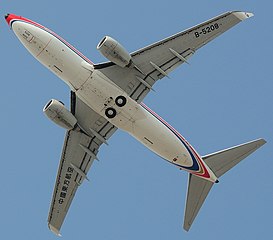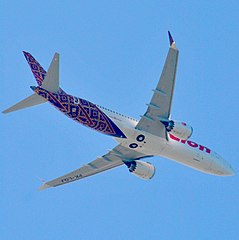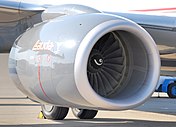
A | B | C | D | E | F | G | H | CH | I | J | K | L | M | N | O | P | Q | R | S | T | U | V | W | X | Y | Z | 0 | 1 | 2 | 3 | 4 | 5 | 6 | 7 | 8 | 9
| Boeing 737 | |
|---|---|

| |
| A Boeing 737-200, the first mass-produced 737 model, in operation with South African Airlink in 2007 | |
| Role | Narrow-body airliner |
| National origin | United States |
| Manufacturer | Boeing |
| First flight | April 9, 1967 |
| Introduction | February 10, 1968, with Lufthansa |
| Status | In production |
| Primary users | Southwest Airlines |
| Produced | 1966–present |
| Number built | 11,743 as of April 2024[update][1] |
| Variants | Boeing T-43 |
| Developed into | |
The Boeing 737 is an American narrow-body airliner produced by Boeing at its Renton factory in Washington. Developed to supplement the Boeing 727 on short and thin routes, the twinjet retained the 707 fuselage width and six abreast seating but with two underwing Pratt & Whitney JT8D low-bypass turbofan engines. Envisioned in 1964, the initial 737-100 made its first flight in April 1967 and entered service in February 1968 with Lufthansa. The lengthened 737-200 entered service in April 1968, and evolved through four generations, offering several variants for 85 to 215 passengers.
The 737-100/200 original variants were powered by Pratt & Whitney JT8D low-bypass turbofan engines and offered seating for 85 to 130 passengers. Launched in 1980 and introduced in 1984, the 737 Classic -300/400/500 variants were upgraded with more fuel-efficient CFM56-3 high-bypass turbofans and offered 110 to 168 seats. Introduced in 1997, the 737 Next Generation (NG) -600/700/800/900 variants have updated CFM56-7 high-bypass turbofans, a larger wing and an upgraded glass cockpit, and seat 108 to 215 passengers. The latest generation, the 737 MAX -7/8/9/10 variants, powered by improved CFM LEAP-1B high-bypass turbofans and accommodating 138 to 204 people, entered service in 2017. Boeing Business Jet versions have been produced since the 737NG, as well as military models.
As of April 2024[update], 16,526 Boeing 737s have been ordered and 11,743 delivered. Initially, its main competitor was the McDonnell Douglas DC-9, followed by its MD-80/MD-90 derivatives. In 2013, the global 737 fleet had completed more than 184 million flights over 264 million block hours since its entry into service. It was the highest-selling commercial aircraft until being surpassed by the competing Airbus A320 family in October 2019, but maintains the record in total deliveries. The 737 MAX, designed to compete with the A320neo, was grounded worldwide between March 2019 and November 2020 following two fatal crashes. A further accident involving an uncontrolled decompression led to the grounding of most 737 MAX 9 aircraft in January 2024.
Development


Initial design
Boeing had been studying short-haul jet aircraft designs, and saw a need for a new aircraft to supplement the 727 on short and thin routes.[2] Preliminary design work began on May 11, 1964,[3] based on research that indicated a market for a fifty to sixty passenger airliner flying routes of 50 to 1,000 miles (100 to 1,600 km).[2][4]
The initial concept featured podded engines on the aft fuselage, a T-tail as with the 727, and five-abreast seating. Engineer Joe Sutter relocated the engines to the wings which lightened the structure and simplified the accommodation of six-abreast seating in the fuselage.[5] The engine nacelles were mounted directly to the underside of the wings, without pylons, allowing the landing gear to be shortened, thus lowering the fuselage to improve baggage and passenger access.[6] Relocating the engines from the aft fuselage also allowed the horizontal stabilizer to be attached to the aft fuselage instead of as a T-tail.[7] Many designs for the engine attachment strut were tested in the wind tunnel and the optimal shape for high speed was found to be one which was relatively thick, filling the narrow channels formed between the wing and the top of the nacelle, particularly on the outboard side.
At the time, Boeing was far behind its competitors; the SE 210 Caravelle had been in service since 1955, and the BAC One-Eleven (BAC-111), Douglas DC-9, and Fokker F28 were already into flight certification.[8] To expedite development, Boeing used 60% of the structure and systems of the existing 727, particularly the fuselage, which differs in length only. This 148-inch (3.76 m) wide fuselage cross-section permitted six-abreast seating compared to the rivals' five-abreast. The 727's fuselage was derived from the 707.[9]
The proposed wing airfoil sections were based on those of the 707 and 727, but somewhat thicker; altering these sections near the nacelles achieved a substantial drag reduction at high Mach numbers.[10] The engine chosen was the Pratt & Whitney JT8D-1 low-bypass ratio turbofan engine, delivering 14,500 pounds-force (64 kN) of thrust.[11]
The concept design was presented in October 1964 at the Air Transport Association maintenance and engineering conference by chief project engineer Jack Steiner, where its elaborate high-lift devices raised concerns about maintenance costs and dispatch reliability.[5]
Major design developments
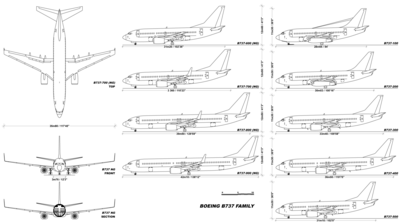
The original 737 continued to be developed into thirteen passenger, cargo, corporate and military variants. These were later divided into what has become known as the four generations of the Boeing 737 family:
- The first generation "Original" series: the 737-100 and -200, also the military T-43 and CT-43, launched February 1965.
- The second generation "Classic" series: 737-300, -400 and -500, launched in 1979.
- The third generation "Next Generation" series: 737-600, -700, -800 and -900, also the military C-40 and P-8, launched late 1993.
- The fourth generation 737 MAX series: 737-7, -8, -9 and -10, launched August 2011.
Launch
The launch decision for the $150 million (~$1.11 billion in 2023) development was made by the board on February 1, 1965.[9] The sales pitch was big-jet comfort on short-haul routes.[12]
Lufthansa became the launch customer on February 19, 1965,[9] with an order for 21 aircraft, worth $67 million (~$494 million in 2023)[8] after the airline had been assured by Boeing that the 737 project would not be canceled.[13] Consultation with Lufthansa over the previous winter had resulted in the seating capacity being increased to 100.[9]
On April 5, 1965, Boeing announced an order by United Airlines for 40 737s. United wanted a slightly larger capacity than the 737-100, so the fuselage was stretched 36 inches (91 cm) ahead of, and 40 inches (102 cm) behind the wing.[7] The longer version was designated the 737-200, with the original short-body aircraft becoming the 737-100.[14] Detailed design work continued on both variants simultaneously.
Introduction
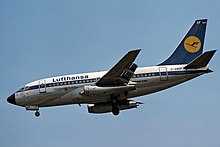
The first -100 was rolled out on January 17, 1967, and took its maiden flight on April 9, 1967, piloted by Brien Wygle and Lew Wallick.[15] After several test flights the Federal Aviation Administration (FAA) issued Type Certificate A16WE certifying the 737-100 for commercial flight on December 15, 1967.[16][17] It was the first aircraft to have, as part of its initial certification, approval for Category II approaches,[18] which refers to a precision instrument approach and landing with a decision height between 98 and 197 feet (30 and 60 m).[19] Lufthansa received its first aircraft on December 28, 1967, and on February 10, 1968, became the first non-American airline to launch a new Boeing aircraft.[16] Lufthansa was the only significant customer to purchase the 737-100 and only 30 aircraft were produced.[20]
The -200 was rolled out on June 29, 1967, and had its maiden flight on August 8, 1967. It was then certified by the FAA on December 21, 1967.[17][21] The inaugural flight for United Airlines took place on April 28, 1968, from Chicago to Grand Rapids, Michigan.[16] The lengthened -200 was widely preferred over the -100 by airlines.[22] The improved version, the 737-200 Advanced, was introduced into service by All Nippon Airways on May 20, 1971.[23]
The 737 original model with its variants, known later as the Boeing 737 Original, initially competed with SE 210 Caravelle and BAC-111 due to their earlier entry into service and later primarily with the McDonnell Douglas DC-9, then its MD-80 derivatives as the three European short-haul single aisles slowly withdrew from the competition. Sales were low in the early 1970s[24] and, after a peak of 114 deliveries in 1969, only 22 737s were shipped in 1972 with 19 in backlog. The US Air Force saved the program by ordering T-43s, which were modified Boeing 737-200s. African airline orders kept the production running until the 1978 US Airline Deregulation Act, which improved demand for six-abreast narrow-body aircraft. Demand further increased after being re-engined with the CFM56.[5] The 737 went on to become the highest-selling commercial aircraft until surpassed by the competing Airbus A320 family in October 2019, but maintains the record in total deliveries.[25]
The fuselage is manufactured in Wichita, Kansas, by Boeing spin-off company Spirit AeroSystems, before being moved by rail to Renton.[26] The Renton factory has three assembly lines for the 737 MAX; a fourth is planned to open at the Everett factory in 2024.[27]
Generations and variants
737 Original (first generation)
The Boeing 737 Original is the name given to the -100/200 and -200 Advanced series of the Boeing 737 family.
737-100
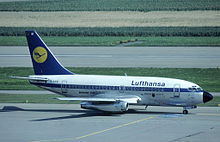
The initial model was the 737-100, the smallest variant of the 737 aircraft family, which was launched in February 1965 and entered service with Lufthansa in February 1968. In 1968, its unit cost was US$3.7M (1968),[28] $32.4M today. A total of 30 737-100s were ordered: 22 by Lufthansa, 5 by Malaysia–Singapore Airlines (MSA) and 2 by Avianca with the final commercial aircraft delivered to MSA on October 31, 1969. The first aircraft used by Boeing as prototype under registration N73700 was later ordered by and delivered to NASA on July 26, 1973, which then operated it under registration N515NA and retired after 30 years on September 27, 2003. This was the last operated 737-100 and is the only remaining worldwide, which is on static display in the Museum of Flight in Seattle.[29][30]
The original engine nacelles incorporated thrust reversers taken from the 727 outboard nacelles. They proved to be relatively ineffective and tended to lift the aircraft up off the runway when deployed. This reduced the downforce on the main wheels thereby reducing the effectiveness of the wheel brakes. In 1968, an improvement to the thrust reversal system was introduced.[31] A 48-inch tailpipe extension was added and new target-style thrust reversers were incorporated. The thrust reverser doors were set 35 degrees away from the vertical to allow the exhaust to be deflected inboard and over the wings and outboard and under the wings. The improvement became standard on all aircraft after March 1969, and a retrofit was provided for active aircraft. Longer nacelle/wing fairings were introduced, and the airflow over the flaps and slats was improved. The production line also introduced an improvement to the flap system, allowing increased use during takeoff and landing. All these changes gave the aircraft a boost to payload and range, and improved short-field performance.[16]
737-200
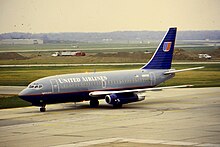
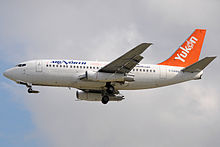
The 737-200 was a 737-100 with an extended fuselage, launched by an order from United Airlines in 1965 and entered service with the launch customer in April 1968. Its unit cost was US$4.0M (1968)[28] ($35M today). The -200's unit cost was US$5.2M (1972)[32] ($37.9M today). The 737-200 Advanced is an improved version of the -200, introduced into service by All Nippon Airways on May 20, 1971.[23] After aircraft #135, the 737-200 Advanced has improved aerodynamics, automatic wheel brakes, more powerful engines, more fuel capacity, and hence a 15% increase in payload and range over the original -200s and respectively -100s.[18][33] The 737-200 Advanced became the production standard in June 1971.[34] Boeing also provided the 737-200C (Combi), which allowed for conversion between passenger and cargo use and the 737-200QC (Quick Change), which facilitated a rapid conversion between roles. The 1,095th and last delivery of a -200 series aircraft was in August 1988 to Xiamen Airlines.[1][35]
Nineteen 737-200s, designated T-43, were used to train aircraft navigators for the U.S. Air Force. Some were modified into CT-43s, which are used to transport passengers, and one was modified as the NT-43A Radar Test Bed. The first was delivered on July 31, 1973, and the last on July 19, 1974. The Indonesian Air Force ordered three modified 737-200s, designated Boeing 737-2X9 Surveiller. They were used as Maritime reconnaissance (MPA)/transport aircraft, fitted with SLAMMAR (Side-looking Multi-mission Airborne Radar). The aircraft were delivered between May 1982 and October 1983.[36]
After 40 years, in March 2008, the final 737-200 aircraft in the U.S. flying scheduled passenger service were phased out, with the last flights of Aloha Airlines.[37] As of 2018, the variant still saw regular service through North American charter operators such as Sierra Pacific Airlines.[38] With the improved short-field capabilities of the 737-200, Boeing offered the option of the gravel kit modification features preventing foreign object damage, which enables this aircraft to operate on remote, unimproved or unpaved runways, such as gravel runways, that other similarly sized jetliners cannot.[39] Until retiring its -200 fleet in 2007, Alaska Airlines used this option for some of its combi aircraft rural operations to serve many unimproved runways in Alaska.[40][41] Gravel-kitted 737-200 Combis are still used by Canadian North (which is due to retire their last one in early 2023),[42] Air Inuit, Nolinor Aviation and Chrono Aviation in Northern Canada where gravel runways are common.
As of September 2023[update], a relatively high number of 737-200s remain in service compared to other early jet airliners, with 50 examples actively flying for 30 carriers.[43] During the 737 MAX groundings, older 737s, including the 200 and Classic series, were in demand for leasing.[44]
737 Classic (second generation)
The Boeing 737 Classic is the name given to the 737-300/400/500 series after the introduction of the -600/700/800/900 series of the Boeing 737 family.[45] Produced from 1984 to 2000, a total of 1,988 Classic series were delivered.[46]
Close to the next major upgrade of single aisle aircraft at Airbus and Boeing, the price of jet fuel reached a peak in 2008, when airlines devoted 40% of the retail price of an air ticket to pay for fuel, versus 15% in 2000.[47][48] Consequently, in that year carriers retired Boeing 737 Classic aircraft to reduce fuel consumption; replacements consisted of more efficient 737 Next Generation or A320 family aircraft. On June 4, 2008, United Airlines announced it would retire all 94 of its Classic 737 aircraft (64 737-300 and 30 737-500 aircraft), replacing them with A320 family jets taken from its Ted subsidiary, which has been shut down.[49][50][51] This intensified the competition between the two giant aircraft manufacturers, which has since become a duopoly competition.
An optional upgrade with winglets became available for the Classic and NG series.
- The 737-300 can be retrofitted with Aviation Partners Boeing winglets. The 737-300 retrofitted with winglets is designated the -300SP (Special Performance).
- WestJet was to launch the 737-600 with winglets, but dropped them in 2006.[52]
737-300

Development began in 1979 for the 737's first major revision, which was originally introduced as the 'new generation' of the 737.[53] Boeing wanted to increase capacity and range, incorporating improvements to upgrade the aircraft to modern specifications, while also retaining commonality with previous 737 variants. In 1980, preliminary aircraft specifications of the variant, dubbed 737-300, were released at the Farnborough Airshow.[54] This first major upgrade series was later renamed 737 Classic. It competed primarily with the MD-80, its later derivative the MD-90, and the newcomer Airbus A320 family.
Boeing engineer Mark Gregoire led a design team, which cooperated with CFM International to select, modify and deploy a new engine and nacelle that would make the 737-300 into a viable aircraft. They chose the CFM56-3B-1 high-bypass turbofan engine to power the aircraft, which yielded significant gains in fuel economy and a reduction in noise, but also posed an engineering challenge, given the low ground clearance of the 737 and the larger diameter of the engine over the original Pratt & Whitney engines. Gregoire's team and CFM solved the problem by reducing the size of the fan (which made the engine slightly less efficient than it had been forecast to be), placing the engine ahead of the wing, and by moving engine accessories to the sides of the engine pod, giving the engine a distinctive non-circular "hamster pouch" air intake.[55][56] Earlier customers for the CFM56 included the U.S. Air Force with its program to re-engine KC-135 tankers.[57]
The passenger capacity of the aircraft was increased to 149 by extending the fuselage around the wing by 9 feet 5 inches (2.87 m). The wing incorporated several changes for improved aerodynamics. The wingtip was extended 9 inches (23 cm), and the wingspan by 1 foot 9 inches (53 cm). The leading-edge slats and trailing-edge flaps were adjusted.[55] The tailfin was redesigned, the flight deck was improved with the optional EFIS (Electronic Flight Instrumentation System), and the passenger cabin incorporated improvements similar to those developed on the Boeing 757.[58] The prototype -300, the 1,001st 737 built, first flew on February 24, 1984, with pilot Jim McRoberts.[58] It and two production aircraft flew a nine-month-long certification program.[59] The 737-300 retrofitted with Aviation Partners' winglets was designated the -300SP (Special Performance). The 737-300 was replaced by the 737-700 of the Next Generation series.
737-400

The 737-400 was launched in 1985 to fill the gap between the 737-300 and the 757-200. In June 1986, Boeing announced the development of the 737-400,[60] which stretched the fuselage a further 10 feet (3.0 m), increasing the capacity to 188 passengers, and requiring a tail bumper to prevent tailstrikes during take-off and a strengthened wing spar.[61] The -400s first flight was on February 19, 1988, and, after a seven-month/500-hour flight-testing run, entered service with Piedmont Airlines that October.[62] The last two -400s, i.e. the last 737 Classics series, were delivered to CSA Czech Airlines on February 28, 2000.[63] The 737-400 was replaced by the 737-800 of the Next Generation series. The 737-400SF was a 737-400 converted to freighter, though it was not a model delivered by Boeing and hence the nickname Special Freighter (SF). Alaska Airlines was the first to convert one of their 400s from regular service to an aircraft with the ability to handle 10 pallets.[64] The airline had also converted five more into fixed combi aircraft for half passenger and freight. These 737-400 Combi aircraft were retired in 2017 and replaced by the 737-700F of the Next Generation series.[65]
737-500
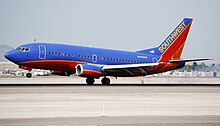
The 737-500 was offered as a modern and direct replacement of the 737-200. It was launched in 1987 by Southwest Airlines, with an order for 20 aircraft,[66] and it flew for the first time on June 30, 1989.[62] A single prototype flew 375 hours for the certification process,[62] and on February 28, 1990, Southwest Airlines received the first delivery.[46]
The -500 incorporated the improvements of the 737 Classic series, allowing longer routes with fewer passengers to be more economical than with the 737-300. The fuselage length of the 737-500 is 1 foot 7 inches (48 cm) longer than the 737-200, accommodating up to 140[61] passengers. Both glass and older-style mechanical cockpits arrangements were available.[62] Using the CFM56-3 engine also gave a 25% increase in fuel efficiency over the older 737-200s P&W engines.[62] The 737-500 has faced accelerated retirement due to its smaller size, after 21 years in service compared to 24 years for the -300.[67] While a few 737-300s were slated for freighter conversion, no demand at all existed for a -500 freighter conversion. The 737-500 was replaced by the 737-600 of the Next Generation series, though the -600 was not as successful in total orders as the -500.
737 NG (third generation)
The Boeing 737 Next Generation, abbreviated as 737 Next Gen or 737NG, is the name given to the main models 737-600/700/800/900 series and the extended range -700ER/900ER variants of the Boeing 737 family. It has been produced since 1996 and introduced in 1997, with a total order of 7,097 aircraft, of which 7,031 have been delivered as of May 2019[update].[1][24] The primary goal was to re-engine the 737 with the high pressure ratio CFM56-7. By the early 1990s, as the MD-80 slowly withdrew from the competition following the introduction of the MD-90, it had become clear that the new A320 family was a serious threat to Boeing's market share. Airbus won previously loyal 737 customers, such as Lufthansa and United Airlines. In November 1993, to stay in the single aisle competition, Boeing's board of directors authorized the Next Generation program to mainly upgrade the 737 Classic series.[68] In late 1993, after engineering trade studies and discussions with major customers, Boeing proceeded to launch a second derivative of the Boeing 737, the 737 Next Generation (NG) -600/700/800/900 series.[1] It featured a redesigned wing with a wider wingspan and larger area, greater fuel capacity, longer range and higher MTOWs. It was equipped with CFM56-7 high pressure ratio engines, a glass cockpit, and upgraded interior configurations. The four main models of the series can accommodate seating for 108 to 215 passengers. It was further developed into additional versions such as the corporate Boeing Business Jet (BBJ) and military P-8 Poseidon aircraft. Following the merger between Boeing with McDonnell Douglas in 1997, the primary competitor for the 737NG series remained only the A320 family.
737-600

The 737-600, the smallest model of the Next-Generation, was launched by Scandinavian Airlines (SAS) in March 1995 with the first aircraft delivered in September 1998.[69] A total of 69 aircraft without winglets have been produced with the last one delivered to WestJet in 2006.[1] The 737-600 replaced the 737-500 and is similar to the Airbus A318.
737-700
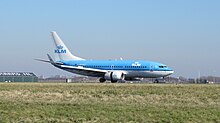
The 737-700, the first variant of the Next-Generation, was launched in November 1993 with an order of 63 aircraft. The -700 seats 126 passengers in a two-class or 149 passengers in a one-class layout. The launch customer Southwest Airlines took the first delivery in December 1997.[70] The 737-700 replaced the 737-300 and competes with the Airbus A319.
The 737-700C is a convertible version where the seats can be removed to carry cargo instead. There is a large door on the left side of the aircraft. The United States Navy was the launch customer for the 737-700C under the military designation C-40 Clipper.[71]
The 737-700ER (Extended Range) was launched on January 31, 2006, and featured the fuselage of the 737-700 and the wings and landing gear of the 737-800. A 737-700ER can typically accommodate 126 passengers in two classes with a range similar to the Airbus A319LR.[72]
737-800
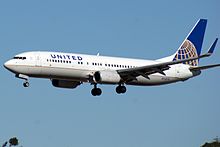
The 737-800 was a stretched version of the 737-700 launched on September 5, 1994. The -800 seats 162 passengers in a two-class or 189 passengers in a high-density, one-class layout. Launch customer Hapag-Lloyd Flug (now TUIfly) received the first one in April 1998.[73] The -800 replaced directly the -400 and aging 727-200 of US airlines. It filled also the gap left by Boeing's decision to discontinue the MD-80 and MD-90 aircraft, following Boeing's merger with McDonnell Douglas. The 737-800 is the most widely used narrowbody aircraft and competes primarily with the Airbus A320.[74]
737-900

The 737-900 was launched in 1997 and took its first flight on August 3, 2000. It retains the MTOW, fuel capacity, trading range for payload and also the exit configuration of the -800, limiting its seat capacity to approximately 177 in a two class and 189 in a high-density, one class layout. The launch customer Alaska Airlines received the delivery on May 15, 2001.[citation needed]
The 737-900ER (Extended Range) is the newest and largest variant of the 737NG generation. An additional pair of exit doors and a flat rear pressure bulkhead increased its seating capacity to 180 passengers in a two-class and up to 220 passengers in a one-class configuration.[75] The -900ER was introduced to meet the range and passenger capacity of the discontinued 757-200 and to directly compete with the Airbus A321.
737 MAX (fourth generation)
The Boeing 737 MAX is the name given to the main models 737 MAX 7/8/9/10 series and the higher-density MAX 200 variant of the Boeing 737 family. It is offered in four main variants, typically offering 138 to 230 seats and a range of 3,215 to 3,825 nautical miles (5,954 to 7,084 km; 3,700 to 4,402 mi). The 737 MAX 7, MAX 8 (including the denser, 200-seat MAX 200), and MAX 9 replace the 737-700, -800, and -900 respectively. The further stretched 737 MAX 10 has also been added to the series. The main development was to re-engine with CFM LEAP-1B very high bypass ratio. On July 20, 2011, Boeing announced plans for a third major upgrade and respectively fourth generation of 737 series to be powered by the CFM LEAP-1B engine, with American Airlines intending to order 100 of these aircraft.[76]
On August 30, 2011, Boeing confirmed the launch of the 737 new engine variant, to be called the Boeing 737 MAX.[77][78][79] It was based on earlier 737 designs with more efficient LEAP-1B power plants, aerodynamic improvements (most notably split-tip winglets), and airframe modifications. It competes with the Airbus A320neo family that was launched in December 2010 and reached 1,029 orders by June 2011, breaking Boeing's monopoly with American Airlines, which had an order for 130 A320neos that July.[80] The 737 MAX had its first flight on January 29, 2016, and gained FAA certification on March 8, 2017.[81][82] The first delivery was a MAX 8 on May 6, 2017, to Lion Air's subsidiary Malindo Air,[83] which put it into service on May 22, 2017.[84] As of January 2019[update], the series has received 5,011 firm orders.[1]
In March 2019, civil aviation authorities around the world grounded the 737 MAX following two hull loss crashes which caused 346 deaths.[85] On December 16, 2019, Boeing announced that it would suspend production of the 737 MAX from January 2020,[86] which was resumed in May 2020. In the midyear 2020, the FAA and Boeing conducted a series of recertification test flights.[87] On November 18, 2020, the FAA cleared the MAX to return to service. Before the aircraft can fly again, repairs must be implemented and airlines' training programs must be approved. Passenger flights in the U.S. are expected to resume before the end of the year.[88] Worldwide, the first airline to resume passenger service was Brazilian low-cost Gol, on December 9, 2020.[89]
737 MAX 7
The 737 MAX 7, a shortened variant of the MAX 8, was originally based on the 737-700, flying 1,000 nautical miles (1,900 km; 1,200 mi) farther and accommodating two more seat rows at 18% lower fuel costs per seat.[90][91] The redesign uses the 737-8 wing and landing gear; a pair of over-wing exits rather than the single-door configuration; a 46-inch-longer (1,200 mm) aft fuselage and a 30-inch-longer (760 mm) longer forward fuselage; structural re-gauging and strengthening; and systems and interior modifications to accommodate the longer length.[92] Entry into service with launch operator Southwest Airlines was expected in January 2019, but the airline deferred these orders until 2023–2024.[93][94] The 737 MAX 7 replaced the 737-700 and was predicted to carry 12 more passengers and fly 400 nautical miles (740 km; 460 mi) farther than the competing Airbus A319neo with 7% lower operating costs per seat.[95]
737 MAX 8

The 737 MAX 8, the first variant of the 737 MAX, has a longer fuselage than the MAX 7. On July 23, 2013, Boeing completed the firm configuration for the 737 MAX 8.[96] Its first commercial flight was operated by Malindo Air on May 22, 2017. The MAX 8 replaced the 737-800 and competed with the A320neo.
The 737 MAX 200, a high-density version of the 737 MAX 8, was launched in September 2014 and named for seating for up to 200 passengers in a single-class layout with slimline seats requiring an extra pair of exit doors. The MAX 200 would be 20% more cost-efficient per seat, including 5% lower operating costs than the MAX 8 and would be the most efficient narrow-body on the market when entering service.[97] In mid-November 2018, the first MAX 200 of the 135 ordered by Ryanair rolled out, in a 197-seat configuration.[98] It was first flown from Renton on January 13, 2019, and was due to enter service in April 2019.[99][100]
737 MAX 9

The 737 MAX 9, the stretched variant of the MAX 8, was launched with an order of 201 aircraft in February 2012. It made its roll-out on March 7, 2017, and first flight on April 13, 2017;[101] It was certified by February 2018.[102] The launch customer, Lion Air Group, took the first MAX 9 on March 21, 2018, before entering service with Thai Lion Air.[103] The 737 MAX 9 replaced the 737-900 and competes with the Airbus A321neo.
737 MAX 10edit

The 737 MAX 10 was proposed as a stretched MAX 9 in mid-2016, enabling seating for 230 in a single class or 189 in two-class layout, compared to 193 in two-class seating for the A321neo. The modest 66-inch (1.7 m) stretch of fuselage enables the MAX 10 to retain the existing wing and CFM Leap 1B engine from the MAX 9 with a trailing-link main landing gear as the only major change.[104] The MAX 10 was launched on June 19, 2017, with 240 orders and commitments from more than ten customers.[105] The variant configuration with a predicted 5% lower trip cost and seat cost compared to the A321neo was firmed up by February 2018, and by mid-2018, the critical design review was completed.[106][107] The MAX 10 has a similar capacity to the A321XLR, but shorter range and much poorer field performance in smaller airports.[108] It was unveiled in Boeing's Renton factory on November 22, 2019, and scheduled for first flight in 2020.[109][110] Boeing also considered parallel development with the 757 replacement, similar to the development of the 757 and 767 in the 1970s.[111]
In the late 2010s, Boeing worked on a medium-range Boeing New Midsize Airplane (NMA) with two variants seating 225 or 275 passengers and targeting the same market segment as the 737 MAX 10 and the Airbus A321neo.[112] A Future Small Airplane (FSA) was also touted during this period.[113] The NMA project was set aside in January 2020, as Boeing focused on returning the 737 MAX to service and announced that it would be taking a new approach to future projects.[114]
Designedit
The 737 continued to evolve into many variants but still remains recognizable as the 737. These are divided into four generations but all are based on the same basic design.
Airframeedit
The fuselage cross section and nose are derived from that of the Boeing 707 and Boeing 727. Early 737 cockpits also inherited the "eyebrow windows" positioned above the main glareshield, which were a feature of the original 707 and 727[115] to allow for better crew visibility.[116] Contrary to popular belief, these windows were not intended for celestial navigation[117] (only the military T-43A had a sextant port for star navigation, which the civilian models lacked.)[118] With modern avionics, the windows became redundant, and many pilots placed newspapers or other objects in them to block out sun glare. They were eliminated from the 737 cockpit design in 2004, although they are still installed on customer request.[119] The eyebrow windows were sometimes removed and plugged, usually during maintenance overhauls, and can be distinguished by the metal plug which differs from the smooth metal in later aircraft that were not originally fitted with the windows.[119]
The 737 was designed to sit relatively low to the ground to accommodate the design of smaller airports in the late 1960s which often lacked jetbridges or motorized belt loaders. The low fuselage allowed passengers to easily board from a mobile stairway or airstairs (which are still available as an option on the 737 MAX) and for luggage to be hand-lifted into the cargo holds. However, the design has proved to be an issue as the 737 has been modernized with larger and more fuel efficient engines.[120]
The 737's main landing gear, under the wings at mid-cabin, rotates into wheel wells in the aircraft's belly. The legs are covered by partial doors, and "brush-like" seals aerodynamically smooth (or "fair") the wheels in the wells. The sides of the tires are exposed to the air in flight. "Hub caps" complete the aerodynamic profile of the wheels. It is forbidden to operate without the caps, because they are linked to the ground speed sensor that interfaces with the anti-skid brake system. The dark circles of the tires are clearly visible when a 737 takes off, or is at low altitude.[121]
From July 2008, the steel landing gear brakes on new NGs were replaced by Messier-Bugatti carbon brakes, achieving weight savings to 550–700 pounds (250–320 kg) depending on whether standard or high-capacity brakes were equipped.[122] On a 737-800 this gives a 0.5% improvement in fuel efficiency.[123]
737s are not equipped with fuel dump systems. The original design was too small to require this, and adding a fuel dump system to the later, larger variants would have incurred a large weight penalty. Boeing instead demonstrated an "equivalent level of safety". Depending on the nature of the emergency, 737s either circle to burn off fuel or land overweight. If the latter is the case, the aircraft is inspected by maintenance personnel for damage and then returned to service if none is found.[124][125]
-
The original 737 with JT8D engines that span the entire wing chord
-
The 737 Classic with larger CFM56 engines mounted mostly ahead of the wing
-
The 737NG with improved CFM56-7 engines
Enginesedit
Engines on the 737 Classic series (-300, -400, -500) and Next-Generation series (-600, -700, -800, -900) do not have circular inlets like most aircraft but rather a planform on the lower side, which has been dictated largely by the need to accommodate ever larger engine diameters. The 737 Classic series featured CFM56 high bypass turbofan engines, which were 25% more efficient and also reduced noise significantly over JT8D low bypass engines used on the 737 Original series (-100 and -200), but also posed an engineering challenge given the low ground clearance of the Boeing 737 family. Boeing and engine supplier CFM International (CFMI) solved the problem by placing the engine ahead of (rather than below) the wing, and by moving engine accessories to the sides (rather than the bottom) of the engine pod, giving the 737 Classic and later generations a distinctive non-circular air intake.[55]
The improved, higher pressure ratio CFM56-7 turbofan engine on the 737 Next Generation is 7% more fuel-efficient than the previous CFM56-3 on the 737 Classic with the same bypass ratio. The newest 737 variants, the 737 MAX series, feature LEAP-1B engines from CFMI with a 69 inches (1.76 m) fan diameter. These engines were expected to be 10-12% more efficient than the CFM56-7B engines on the 737 Next Generation series.[126]
Text je dostupný za podmienok Creative Commons Attribution/Share-Alike License 3.0 Unported; prípadne za ďalších podmienok. Podrobnejšie informácie nájdete na stránke Podmienky použitia.
Antropológia
Aplikované vedy
Bibliometria
Dejiny vedy
Encyklopédie
Filozofia vedy
Forenzné vedy
Humanitné vedy
Knižničná veda
Kryogenika
Kryptológia
Kulturológia
Literárna veda
Medzidisciplinárne oblasti
Metódy kvantitatívnej analýzy
Metavedy
Metodika
Text je dostupný za podmienok Creative
Commons Attribution/Share-Alike License 3.0 Unported; prípadne za ďalších
podmienok.
Podrobnejšie informácie nájdete na stránke Podmienky
použitia.
www.astronomia.sk | www.biologia.sk | www.botanika.sk | www.dejiny.sk | www.economy.sk | www.elektrotechnika.sk | www.estetika.sk | www.farmakologia.sk | www.filozofia.sk | Fyzika | www.futurologia.sk | www.genetika.sk | www.chemia.sk | www.lingvistika.sk | www.politologia.sk | www.psychologia.sk | www.sexuologia.sk | www.sociologia.sk | www.veda.sk I www.zoologia.sk

